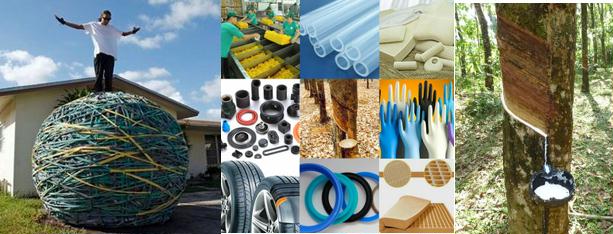
Rubber trees can’t be grown anywhere. They require 100 inches (250 cm) of rain year round. Dry seasons not allowed. The average monthly temperature should be 77 to 82 Fahrenheit (25-28 C), with 6 hours a day of bright sunshine, at least 2000 hours a year, and no strong winds allowed. In ideal conditions, two tons of rubber can be produced per hectare a year.
Yet growing rubber harms biodiversity, deforestation, pollution and more. Especially in the tropical regions of Thailand, Indonesia, Malaysia, Vietnam, India & China where most rubber is grown on over 12 million hectares since too many pests destroy them in their native South America. But now these diseases are spreading to Asia. In addition, natural rubber supplies are tight due to covid-19, natural disasters, and supply chain delays. Nor can rubber trees be scaled up quickly, it takes seven years for a rubber tree to mature.
Over 75% of this rubber is used for 40,000 products that require its unique properties of high flexibility, durability, and water resistance. There is no substitute. Above all, vehicle tires need to be mostly natural rubber — that’s how two-thirds of rubber is used — as well as being essential for many industrial products and in construction, electronics, cables, shoes, medical devices and more.
Many have tried to use other plants. A century ago Henry Ford tried with dandelions, goldenrod, and sunflowers. The most promising plant today is a a dandelion from Kazakhstan with roots of 10-15% natural rubber, but it is years from becoming commercially viable if it can be. They are slow to establish and mature, and easily overtaken by weeds. They have to be genetically engineered to be unable to cross pollinate with other plants, withstand weeds and toxic pesticides, and have a stronger disease resistance.
The upside of peak rubber is peak peace. Military aircraft, tanks and other weapons must have natural rubber tires and other components. With Russia tempted to use nuclear weapons to destroy Ukraine launching WW III and the extinction of much of life on earth, declining natural rubber doesn’t sound like such a bad thing.
Alice Friedemann www.energyskeptic.com Author of Life After Fossil Fuels: A Reality Check on Alternative Energy; When Trucks Stop Running: Energy and the Future of Transportation”, Barriers to Making Algal Biofuels, & “Crunch! Whole Grain Artisan Chips and Crackers”. Women in ecology Podcasts: WGBH, Jore, Planet: Critical, Crazy Town, Collapse Chronicles, Derrick Jensen, Practical Prepping, Kunstler 253 &278, Peak Prosperity, Index of best energyskeptic posts
***

One Response to Peak Rubber